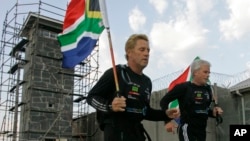Two South African rowers pushed off from the coast of Cape Town earlier in February and began what they hope will be a record-breaking journey to Rio de Janeiro. If they succeed, they will be the first to row across the southern Atlantic. Their goal in undertaking such a voyage: to raise awareness about climate change.
The entire distance for rowers Braam Malherbe and Wayne Robertson is 6,400 kilometers as the crow flies, but they plan to row much farther to take advantage of currents and prevailing winds. Their route takes them north along the African coast before turning west, paddling past the island of St. Helena in the mid-Atlantic, and then south to Rio, says Malherbe.
Their boat, at barely seven meters long, includes a watertight bubble at the bow, where the two oarsmen can rest or take shelter in a storm.
However, they will spend most of their time in the rowing seats on the narrow deck that lies just two feet above the waterline.
"So it's rowing two hours, resting two hours, 24-7, through the day, through the night, for up to 90 days," Malherbe said. "We're hoping that we're going to have tailwinds, which means we could possibly complete it in as little as 60 days."
Malherbe is no stranger to grueling endeavors.
In the past decade, he has run the length of the Great Wall of China; raced on foot to the South Pole in temperatures of 45 degrees below zero (Celsius); and run the Southern African coastline to fund cleft-palate operations for children.
He says mental strength is key.
"I've done a lot of work on the erg, the rowing machine that I have at home: technique, skilled stuff," Malherbe said. "I've got a bloke called Guy Biscoe, he's my rowing coach. On the water, I've only done probably 50 kilometers on this thing in bits and pieces — two hours on, two hours off, two hours on, getting my head right. Because if you over-train, you're going to injure, and at my age, 59, I don't want to injure. So I rather go slower, err on the side of caution, and build up my fitness as I get closer to Rio. Halfway mark, I should be peaking."
The two men are traveling without a support vessel, which means they are alone in the risks they face. Whales are one hazard — the creatures sleep on the surface of the water, and hitting one would roll their boat.
"The boat will self-right, but it's still not pleasant," Malherbe said.
But their greatest danger is ships at night.
"We have what's called an AIS on the vessel, line of sight. So it will pick up a vessel and go beep, beep, beep and send an alarm," Malherbe said. "But they don't change course, and sometimes there's not even anyone on the bridge. So being hit by a ship, it's over for us."
All of which raises the question: Why do it?
Malherbe is a noted conservationist in his native South Africa. By rowing the southern Atlantic, he is hoping to encourage people to find out how they can tackle climate change.
Like many things these days, there is an app for that. Called the DOT Challenge, which stands for Do One Thing, its purpose is to encourage people to take action in four categories — conservation, water, waste and energy — and share what they've done.
"That's the purpose of this journey — 2.3 million pulls to get to Rio. We're hoping to have 2.3 million people on that app doing one thing for the planet by the time we reach Rio," Malherbe said.
If the winds are in their favor, Malherbe and Robertson expect to reach Rio in April.











